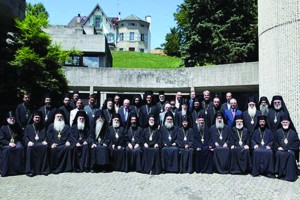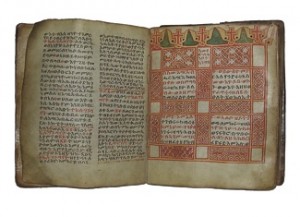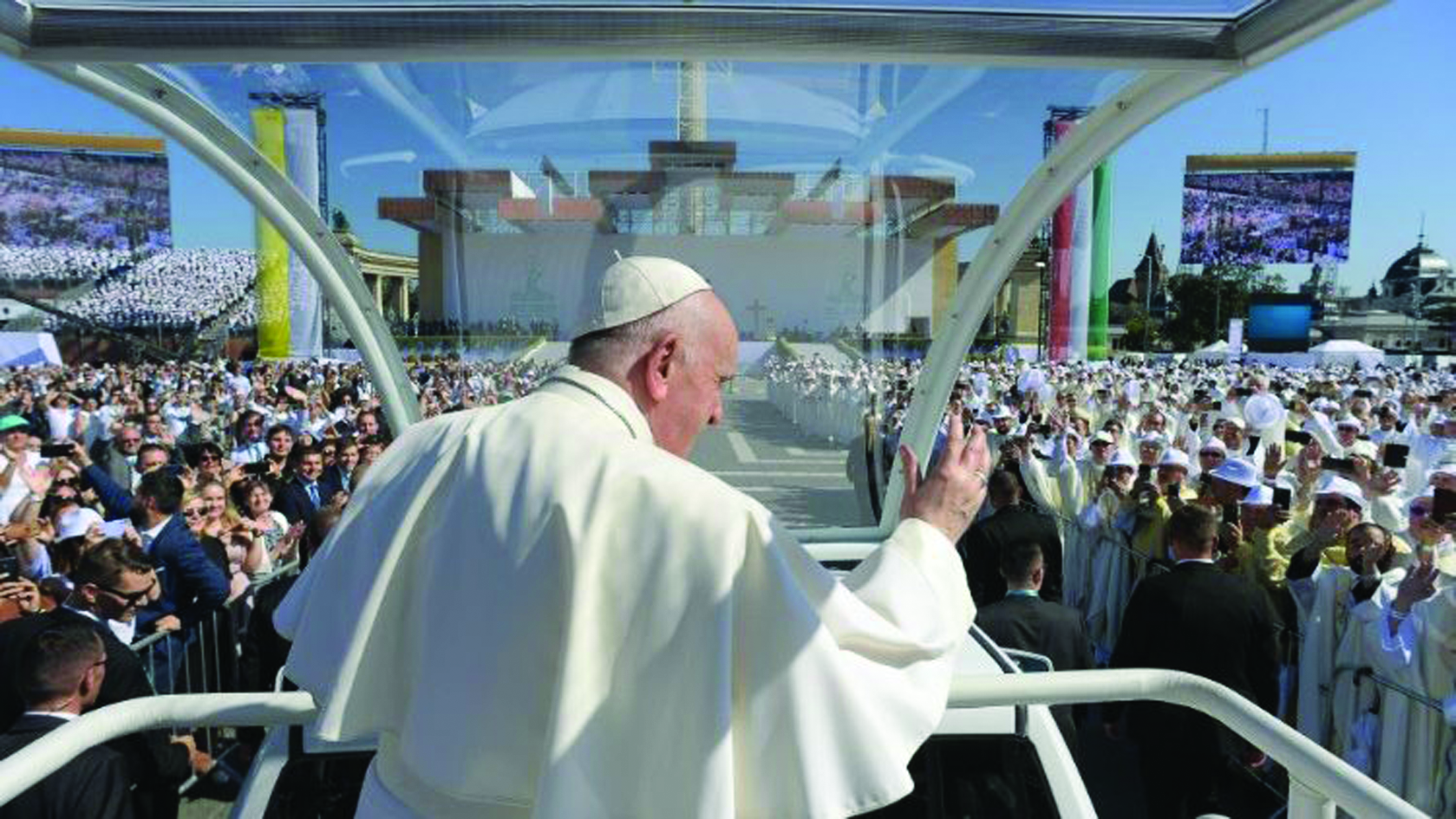
Chambesy, Switzerland. A group of delegates at the Fourth Pan-Orthodox Pre-Council Conference
Orthodox Clear Way to Historic Pan-Orthodox Council
After a five-day conference, called a “synaxis,” held during January in Chambesy, Switzerland, representatives of all 14 of the autocephalous (self-governing) Churches of the Orthodox Christian communion agreed to go forward with the “Great Pan-Orthodox Council” tentatively planned for Pentecost of this year.
The long hoped-for historic Council — another of its exact kind has never been held — will take place from June 16 to 27 at the Orthodox Academy of Crete, 15 miles from the city of Chania, on the north coast of the Greek island of Crete. The original plan for the Council envisioned the gathering at the Church of Hagia Irene in Istanbul, where the Second Ecumenical Council was held in the year 381. However, after the deterioration of Russian-Turkish relations in recent months, the Russian delegation’s security concerns were addressed by moving the Council to the less historically significant, but more politically neutral, Crete.
Discussions about holding the historic Pan-Orthodox Great Council have been in the works at least as far back as the 1960s, though the fall of the Iron Curtain in 1991 accelerated the pace of talks. Unlike that of the Roman Catholic Church, the structure of the Orthodox Communion of Churches is a “synodal” one, in which a consensus is generally required for the adoption of proposals; hence, the sometimes painful slowness with which issues are decided.
Among the major subjects that have slowed the process of organizing the Great Council are jurisdictional and primatial issues among the autocephalous churches about which general agreement has remained elusive. Ecumenical Patriarch Bartholomew of Constantinople and Russian Patriarch Kirill of Moscow have clashed over the contested boundaries of their respective jurisdictions, especially in the Diaspora, but also in the historically Orthodox lands, including Ukraine. The Ecumenical Patriarchate of Constantinople also tends to assert a notion of primacy which gives an authority to that Patriarch over the Orthodox of the East which resembles the authority of the Pope over the Western Church. The Moscow Patriarchates and some other Patriarchates understandably object, proposing a more “first among equals” model.
Other disagreements include a jurisdictional dispute between the Antioch and Jerusalem Patriarchates over the Qatar territories, to which both Churches lay claim. In April 2013, the Antiochan Patriarch broke off communion with the Jerusalem Patriarchate over the issue. Another important dispute is the fate of the Orthodox Churches in Ukraine. The largest of the three main groups there is the Ukrainian Orthodox Church (Moscow Patriarchate), the ecclesial body recognized canonically by the other Orthodox Churches. The standing of the other two — the Ukrainian Orthodox Church (Kiev Patriarchate) and the Ukrainian Autocephalous Orthodox Church — is still unresolved, but Ecumenical Patriarch Bartholomew favors finding a way to reconcile the Churches in the Ukrainian schism.
Similar successful efforts in the Orthodox Church of the Czech and Slovak lands offers some hope that normalizing the ecclesiastical standing of these Ukrainian Churches could become a reality, presenting a possible path to eventual unity and even autocephaly.
Paul L. Gavrilyuk, professor of theology at the University of St. Thomas in St. Paul, Minnesota, notes that “such a move is likely to provoke fierce resistance from Moscow, even to the point of potentially breaking communion with Constantinople.” Still, he continues, “If one follows the history of the emergence of the national Orthodox Churches in the 19th and 20th centuries, one realizes that the eventual autocephaly of the Ukrainian Orthodox Church is only a matter of time.”
At the Synaxis held in Chambesy in January, several elements of the Pan-Orthodox Council were decided upon, including the rules that will govern the Council, summed up in 16 articles. According to Metropolitan Nifon of Targoviste, Romania, these rules relate to “the definition of the Holy and Great Council, its structure, the powers of the President, and many other practical issues such as the terms of invitations to be made to other Christian Churches and international organizations.”
With respect to the approved documents, Metropolitan Nifon specifically referred to: 1) Autonomy and the manner of its declaration; (2) Relations of the Orthodox Church to the rest of the Christian world; (3) The importance of fasting and its observance today; (4) The Orthodox Diaspora; and (5) The mission of the Orthodox Church in the contemporary world [to promote Christian ideals of peace, freedom, brotherhood and love among peoples].
Patriarch Kirill spoke to journalists when he left Chambesy on January 27, indicating that a document on the impediments to marriage and the family in general had also been approved. The Patriarch also stated that all of the approved documents will be published in the “near future.”
Subjects of discussion that the pan-Orthodox Council apparently may not consider are: (1) Autocephaly and its manner of proclamation; (2) The Diptychs [the order of honor of the local churches]; and (3) The matter of a common calendar. Presumably, these will be considered at a subsequent pan-Orthodox Council. —ITV staff
Russian Patriarch Blames Rise of Isis on World Acceptance of Homosexuality
For the head of the Russian Orthodox Church, Patriarch Kirill, the rise of the radical jihadist group Islamic State (ISIS) can be attributed to the world’s acceptance of homosexuality.
In an article in The Independent UK, the 69-year-old religious leader expressed the belief that Muslims are now flocking to join ISIS because they want to escape the “godless civilization” that highlights immorality with such events as a gay pride parade.
“(ISIS) is creating a civilization that is new by comparison to the established one that is godless, secular, and even radical in its secularism,” Kirill said.
“We can have parades for the sexual minorities — that is supported — but a million French Christian protestors defending family values are broken up by police,” he said. “Look how they (the West) build the world — an unholy world — but we invite you to build God’s world… and they (ISIS supporters) respond to that; it is for this that they give their lives.”
Kirill claimed that he can “offer more simply frightening examples of how the godless civilization is growing,” but the sad reality is that ISIS is now converting young people who want to restore order and uphold religious views.
“You become a fighter for the Caliphate. So what’s a Caliphate?” he questioned. “It is a society centered around faith and God where people follow religious laws.”
— Christiantoday.com
Oldest Monastery in Iraq destroyed by ISIS
“T he Islamic State terror group has destroyed the oldest Christian monastery in Iraq, satellite photos have confirmed, reducing to rubble the 1,400 year-old St. Elijah’s Monastery that stood as a place of worship before the Catholic-Orthodox split.
The Associated Press reported on January 13 that it obtained satellite photos from imagery firm DigitalGlobe, which revealed that the site where St. Elijah’s Monastery, built in 590, once stood has been reduced to a field of rubble.
Vatican spokesman Rev. Federico Lombardi pointed out that the monastery was a special place for many, because it dated back to a time before the split between the Catholic and the Orthodox traditions.
“Unfortunately, there is this systemic destruction of precious sites, not only cultural, but also religious and spiritual.” Lombardi said. “It’s very sad and tragic.”
— Christianpost.com
American University returns 15th century manuscript to Ethiopian Orthodox Monastery
“ A delegation from Howard University Divinity School returned an ancient manuscript to the Ethiopian Debre Libanos Monastery on January 11 after scholars discovered its place of origin.
The manuscript contains two texts, the Acts of Paul and the Acts of Serabamon, and is part of one of the largest collections of Ethiopian sacred artifacts in the U.S. The manuscript was owned by the late Dr. Andre Tweed, a prominent psychiatrist and Howard alumnus who donated it in 1993.
Pollard said the centuries-old books are sacred to the Ethiopian Orthodox Church and are distinct from the Book of Acts in the New Testament. They describe the work and life of the Apostle Paul and the lesser-known story of Serabamon, a martyred bishop in the early Church who was named a saint.
He said the just-returned Tweed manuscript was ordered by the 15th-century abbot of the monastery, who was the indigenous leader of the Ethiopian Orthodox Church at the time. — RNS







Facebook Comments